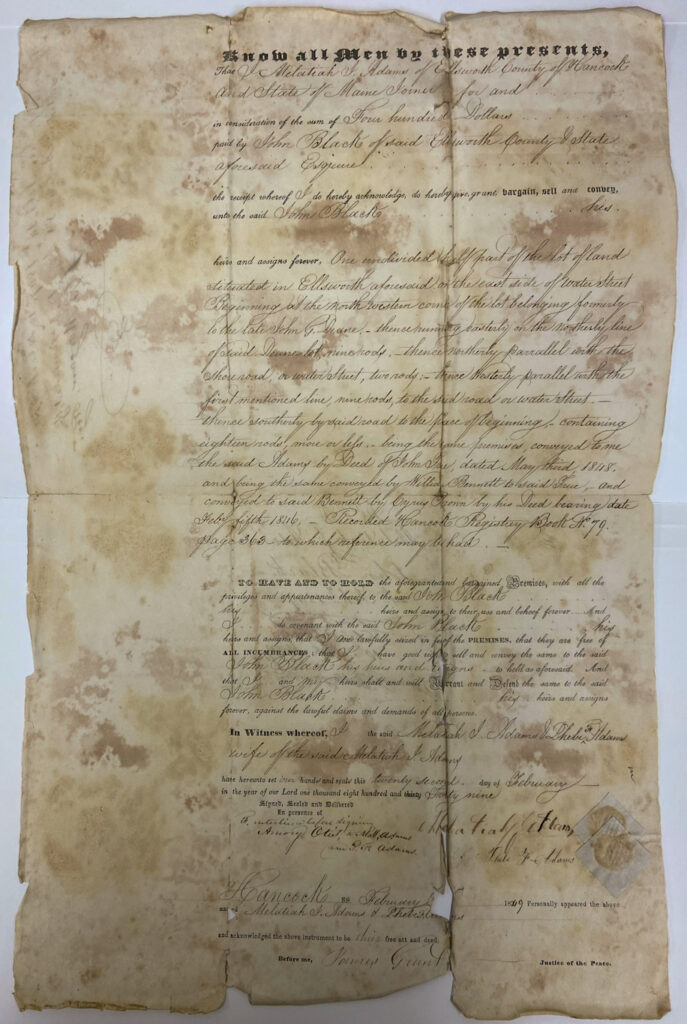In 1928, the Hancock County Trustees of Public Reservations were given a property rich in local and regional history, one that continues to provide valuable lessons and experiences in the 21st century. The property encompasses a historic house surrounded by 200 acres of fields and forest that was part of the Black family’s estate from 1827 to 1928. The house retains its original furnishings, reflecting a century of occupancy by three generations of one family. From pillow cases and iron cookware to silver and fine paintings, the objects inform today’s visitors about life in the 1800s. People might view carriages and sleighs used by the family or walk the trails that were once exercise tracks for horses.


Extensive Woodlawn Archives
Importantly, the surviving archive of Black Family Papers contains insightful information about the social and economic development of Hancock and Washington County communities. Embedded in the family’s lumber, shipping and mercantile records are the names and roles of average people who did the basic work of community building. Contracts for road and bridge building exist alongside receipts for dressmaking and doctor’s visits. Deeds and land surveys within the townships managed by John Black combined with Black and Sons daybooks listing basic consumables purchased by individuals all paint a portrait of life in the region. There are even daily temperature and weather records kept by the Blacks for more than 30 years. The archives are filled with information still to be discovered; stories waiting to be told.
Black Family Homestead, 1827-1928
On November 7, 1827, John and Mary (Cobb) Black moved into their newly built brick mansion uphill from the Union River in Ellsworth, Maine. They called their new home “Woodlawn”. At the time, the couple were in their late forties and had 8 children ranging in age from 9 to 24. By all measures, John Black was a very successful man having made his fortune in lumbering, shipping, and as the primary land agent for the estate of the 1790s land speculator, William Bingham.
The new house was intended to make a bold statement about Colonel John Black’s wealth and status. Patterned after a design published in 1816 in The American Builder’s Companion by American architect Asher Benjamin, and built by carpenters and masons brought to Ellsworth from Taunton, Massachusetts. The mansion is considered one of Downeast Maine’s 19th-century architectural masterpieces.


John and Mary filled their home with the finest furniture, carpets, silver, and textiles that the couple could purchase in Boston. Surrounding the mansion, Black established his “gentleman’s farm” consisting of a large barn, various outbuildings, gardens, an orchard, hay fields, pastures, and forestland. A family tomb was added in the 1840s.
When John and Mary passed away in the 1850s, the property was handed down to their son, George Nixon Black, and later to George Nixon Black, Jr. In 1928—upon the death of the latter who had no descendants—Woodlawn was bequeathed to the Hancock County Trustees of Public Reservations. It was opened the next year as a public park and seasonal house museum.
Woodlawn Today
The property is the only one of its kind accepted by the Hancock County Trustees of Public Reservations, and the only property that the Trustees continue to own and administer. Today, Woodlawn is noteworthy for its original Black family furnishings, extensive family archives, and as a community resource for educational, cultural, and recreational opportunities. It is a place where people feel connected to the past amidst authentic collections and stories, a place where ongoing research continually yields greater understanding of the past that informs our future.

